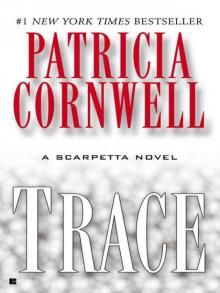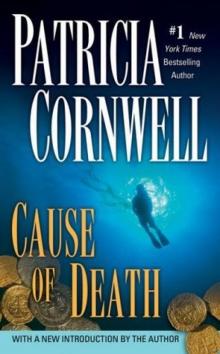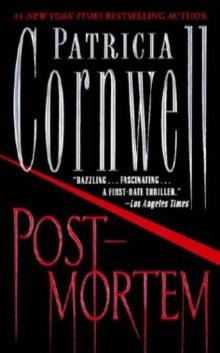- Home
- Patricia Cornwell
Isle of Dogs Page 4
Isle of Dogs Read online
Page 4
Hammer was new, not a Virginian, and therefore an easy target. Trader didn’t like her anyway. Superintendents in the past had always been burly, tough men from old Virginia families, and they understood pecking orders and paid appropriate respect to the press secretary, who ultimately controlled what the governor thought and what the public believed. Hammer was a disgrace. She was a blunt, confrontational female who often wore pants, and when Trader had met her the day she was interviewed for the superintendent’s position, she had looked right through him as if he were air and hadn’t laughed at or even noticed his off-color anecdotes and jokes.
Trader’s fingers paused on the computer keyboard, and then he began to compose an e-mail:
Dear Trooper Truth,
I read your “Brief Explanation” with great interest, and hope you can address the concern of an old woman like me who never married and lives alone and is afraid to drive because of all the crazies on the road, including those awful pirates!
But I certainly don’t think the answer is speed traps and helicopters that go roaring after honest citizens! VASCAR is going to start another civil war, and I hope you will address this in your next essay.
Sincerely,
A. Friend
Trader didn’t intentionally put a period after the A, and he didn’t notice the typo as he hit SEND NOW. He realized his mistake when he got a response moments later:
Dear Miss A. Friend,
Thank you for your interest. I’m very sorry you are lonely and afraid to drive. That makes me sad, and please feel free to write me anytime. What is VASCAR?
Trooper Truth
Major Trader decided he might as well be Miss A. Friend from now on, and he fired off another e-mail:
Dear Trooper Truth,
I’m so pleased you would take the time to answer a lonely old woman. Superintendent Hammer knows what VASCAR is. It was her idea. I’m surprised you haven’t heard all about the speed traps she’s going to put on Tangier Island and can’t help but suspect she got the idea from your “Brief Explanation.” I applaud you for influencing her to make an example of people who once were in bed with pirates and now take advantage of tourists.
Sincerely,
Miss A. Friend
Trader chortled as he dashed off a memo to Hammer. It was brief and confusing, and was accompanied by a press release that was to be circulated immediately, on orders of the governor.
WHAT the hell is this?” Hammer asked when her secretary, Windy Brees, handed her a fax from the governor’s office that informed her of a new speed monitoring program called VASCAR.
“New to me,” replied Windy. “What a stupid name. I mean, it doesn’t mean anything, if you ask me, except it reminds me of NASCAR, and I bet the governor didn’t think about that. Just another example of not looking before you leak.”
Hammer read the memo and press release several times, furious that the governor would implement a state police program without conferring with her first.
“Goddamn it,” she muttered. “This is the stupidest thing I’ve ever heard of. We’re going to start using helicopters to monitor how fast drivers are going? And the first target is Tangier Island, the news of which is to remain classified until white reflective stripes have been painted on what few roads they have out there? Get the governor on the phone for me immediately,” Hammer ordered Windy. “He’s probably in his office. Tell whoever answers that it’s urgent.”
Windy returned to her desk and rang up the governor’s office, knowing it would do no good. The governor never returned Hammer’s calls and had not met with her once since he appointed her. Windy had learned to fabricate elaborate excuses for her inability to get the governor to respond to Hammer. “One thing’s for sure,” Windy often told the other secretaries and clerks when they were outside on smoking breaks, “a stitch in the hand is worth two in the butt,” which was her way of saying that by fudging to her boss, Windy was taking preventive measures so she didn’t get her ass kicked when she had to tell Hammer that the governor, as usual, couldn’t be bothered with his female state police superintendent.
Windy’s acquaintances and colleagues had long since stopped correcting Windy’s malapropisms, and by now, no matter how badly she mangled a cliché, most people knew what she meant and, in fact, became vague about what the cliché was supposed to be and ended up reciting the mangled ones. This was maddening to Hammer, who was repeatedly subjected to her staff writing off into the sunset or accusing someone of marching to a different color.
“Superintendent Hammer?” Windy hovered in the doorway. “I’m sorry, but the governor can’t be reached at the moment. Apparently, he’s in transition.”
Hammer looked up from a stack of reports and memos she was reviewing. “What do you mean, he’s in transition?”
“Traveling somewhere. Maybe even walking back to the mansion. I’m not sure.”
“He’s in transit?”
“Or on his way there, I guess.” Windy got more tangled up in her fib. “But I don’t think anybody can reach him right now, to cut to the point. So it’s not just you.”
“Of course it’s just me!” Hammer looked at the VASCAR memo again, wondering how she would handle the administration’s latest and perhaps most damaging lamebrain decision. “He’s not going to talk to me and you can stop trying to make me feel better about it.”
“Well, it’s not nice of him.” Windy put her hands on her hips. “And I hope you won’t get mad at me just because of how he treats you. It’s not fair to shoot the messenger.”
Kill the messenger, Hammer irritably thought. You shoot the piano player and kill the messenger. My God, I can’t stop thinking in clichés! And I hate clichés!
“One of the men I was dating last month told me that the only reason the governor appointed you is because he’s always getting bad press about all our highway problems and needs someone he can pass the scapegoat to,” Windy said, “and I don’t think you should blame yourself for that or take it personal.”
Hammer could not believe she had inherited such a hairball for a secretary. If only it weren’t so difficult to fire state employees. No wonder the last superintendent had retired early with a heart condition and Parkinson’s disease, but what the hell had been on his mind when he hired Windy Brees? For starters, how do you get past her name? And it should have been apparent the first time she opened her mouth that she was an embarrassment and incompetent, a perky little idiot caked with makeup who minced about, tilting her head this way and that in an attempt to appear submissive and cute and in need of powerful men to take care of her.
IT was past 6:00 P.M., and Hammer packed up her briefcase and headed home. She drove through downtown feeling certain that VASCAR was going to ruin her career and there didn’t seem to be a thing she could do about it. Was it merely coincidental that the very day Andy launched a website that was supposed to make the state police look good, the governor had decided to launch a program that would make the state police look bad? Was it mere chance that Andy had rather much slammed Tangier Island by indicating that it had once been a nest for pirates, and now the governor was going after the Islanders? Not to mention, she was desperately short of helicopter pilots and the few troopers left in the aviation unit needed to spend their time looking for criminals and marijuana fields, as opposed to tracking speeders on a tiny island or elsewhere.
Hammer brooded about Andy as she continued working herself into a state of fulminating paranoia. She should never have allowed him to write his Internet essays uncensored. But that had been part of the agreement.
“I’m not doing it if you edit me,” he had told her last year. “One obvious reason for anonymity is that no one knows what Trooper Truth is going to say or has any control over it, otherwise the truth would be lost. If you read my essays before they’re posted on the Internet, Superintendent Hammer, then I know very well what you’ll do. You’re going to start worrying about criticisms, blame, and political problems. That’s what bureaucrats focu
s on, unfortunately. Not that I’m calling you a bureaucrat.”
“Of course that’s what you’re calling me,” she had said, deeply offended.
And maybe he was right, Hammer dismally thought as she followed East Broad Street toward her restored neighborhood of Church Hill. Maybe she was turning into a bureaucrat who was far too consumed by what people thought and said about her. What had happened to her firm but diplomatic way of dealing with complaints and demands from the public?
She called Andy on her cell phone. “We have a potential emergency,” she told him. “The governor wants to put speed traps on Tangier Island and all hell’s going to break loose.”
“I heard about it,” he said.
“How?” She was startled.
“I wish you had said something to me,” Andy added in frustration as he sat in front of his computer, going through the hundreds of e-mails Trooper Truth had gotten so far this day. “I didn’t even have a clue until Miss Friend sent me an e-mail. I may need an assistant. I’ll never keep up with all the mail I’m getting,” he declared as his computer announced you’ve got mail! four more times.
“VASCAR wasn’t my idea, for God’s sake!” Hammer replied. “And who is Miss Friend? The focus right now should be on these outrageous hijackings and assaults—not on speeding! Andy, I need your help with this. We’ve got to figure out what to do.”
“There’s only one thing to do,” he said as he typed. “I’ll go to Tangier Island myself and paint a speed trap and see what the response is. Better I should do it than someone else, and I can use Trooper Truth to counter any negativity directed at you and the state police, and I’ll show the public what a bad idea VASCAR is, and maybe the governor will drop the damn program and let us work real crimes. All I need is a couple cans of reflective, fast-drying paint, a brush, a helicopter, and a little time to appropriately revise tomorrow’s essay on mummies.”
“What the hell do mummies have to do with anything?” Hammer protested.
MUMMIES
by Trooper Truth
Like most people, I grew up watching mummies in horror films. Having done a lot of archaeological research of late, I can tell you, the reader, that these terrifying depictions of a living dead person bound in strips of cloth aren’t accurate—or fair.
Mummies can’t hurt us unless they spread an infectious disease from antiquity, which isn’t likely, although I suspect you could suffer an adverse respiratory reaction after inhaling layers of dust in a creepy, cold place. I suppose you could injure yourself while looking for a mummy or find yourself lost deep inside a pyramid and die of thirst and starvation, or you could certainly encounter a grave robber and get into a violent altercation.
In death investigation, the term mummy refers to a dead person whose body has been exposed to extreme cold or aridness. Instead of decomposing, the body dries out and can remain in this state of preservation for decades or hundreds of years. This type of mummy, which typically shows up in cellars or the desert, is not a true mummy, but you can rest assured that anthropologists and others will refer to dried-out bodies as mummified because the term is here to stay. I will admit that it probably sounds better for an expert witness to say a victim was mummified than to admit that the poor soul was shriveled up and dried out and looked like a skeleton covered with shoe leather.
The word mummy is derived from the Arabic word for bitumen, which in the original Persian form meant wax. So mummy is a substance such as bitumen, which is a type of asphalt used in Asia Minor, and a mummy is a person or animal that has been preserved by artificial means, although it would not be accurate in modern times to refer to an embalmed body as a mummy. The reason for this is simple. Bodies embalmed with formaldehyde are not necessarily well preserved. If you dig up an embalmed body a hundred years later, depending on where it was buried, you are probably going to find that the dead person isn’t as well preserved as a thousand-year-old Egyptian mummy.
In our society, we do not fill the embalmed person’s belly with pure myrrh, cassia, and other perfumes, nor do we stuff bitumen into the limbs or steep the body in the mineral natron for seventy days before tightly binding it in strips of flaxen cloth that are then smeared with gum, which is what the Egyptians often used instead of glue. A modern embalmed body is not placed inside a human-shaped wooden case that is leaned up against a wall inside a cool, dry sepulcher.
I’m not saying that you couldn’t preserve your dead loved one in this ancient manner, assuming you are able to find a trained scribe to mark the body for the embalming incision and then a practitioner called a ripper up to assist with a sharp Ethiopian stone before he flees because the Egyptians considered it a crime for anyone to physically violate the dead, even if the ripper up was legitimately hired to do so, according to the Greek historian Diodorus. And assuming you’re willing to pay for it, a deluxe embalming in the Egyptian fashion costs about one talent of silver, which is approximately four hundred U.S. dollars, depending on inflation and the exchange rate.
Not so long ago, my interest in mummies led me to Argentina where scientists were in the midst of doing numerous tests on them, such as MRIs, CAT scans, and DNA needle biopsies. I got in touch with National Geographic to see if I might be allowed to visit the mummies, and I was told, “Okay,” as long as I didn’t say a word about it until after the cover story was published.
It was a cool, bright morning when I arrived in Salta, a city in northwestern Argentina that has become a center of archaeological investigations of Inca and other pre-Columbian Indian cultures. There I joined the archaeologists who had headed the expedition on an Andean volcano peak on the Argentine-Chilean border, where they had discovered three perfectly preserved five-hundred-year-old mummies of Inca children who had been offered as ritual sacrifices and buried with gold, silver, and pots of food. The archaeologists took me in a Jeep along a dusty road to Catholic University, where a small building had been turned into a temporary laboratory that was heavily patrolled by guards armed with machine guns. Grave robbers, like pirates, have remained a constant threat to our society, even in remote locations.
As I watched the archaeologists carry the first small bundle from a freezer and set it on a paper-covered examination table, I realized that unwrapping the frozen remains of two Inca girls and a boy who had been killed half a millennium ago was not unlike my working car accidents and violent crime scenes. The major difference is that in archaeology, the artifacts and causes of death are studied with no thought of bringing anyone to justice, but rather to interpret a mysterious and elusive past, which in this case was that of a people who had no written language but revealed their history through elaborate textile weaving and art. I confess that I didn’t care much about diseases, diets, costumes, and customs, but was preoccupied with whether the Inca children had been unconscious, due to altitude and ritual alcoholic drinks like chicha (corn beer), when they were buried alive.
I wondered what the two girls and boy thought when they were dressed in fine woven outfits, feathered headdresses, and jewelry, and taken by processions up 22,057 feet to the summit of Mount Llullaillaco. I hoped they didn’t know what was happening when they were wrapped in cloth and placed sitting up in deep graves that the Incas finally filled with rocks and earth in hopes that the gods would be pleased.
I can still envision the faces of those three murdered children, especially the boy, who was possibly around eight years old when he was dressed in fur-trimmed moccasins and a silver bracelet, and sent on his journey to the Afterlife with two extra pairs of sandals and a sling for hunting. His expression was one of distress and protest, and his knees were drawn in a fetal position, his ankles tightly bound with cord. I suspected he had been alert and none too happy about his role in religion, and I had a bad feeling that he resisted and was awake as he was smothered with soil and stone. The girls, possibly eight and fourteen, were not bound and looked rather placid, but oddly, one of their graves had been struck by lightning, and when the little mummy was unwrapped
in the makeshift lab in Salta, I could still smell the odor of burned human flesh. It seemed to me that the Almighty had let the Incas know that He wasn’t pleased in the least about their burying little children alive.
Not much ever changes, I’m sorry to say. Continuing to research our past, I spent time at the Jamestown excavation site and made pilgrimages to Great Britain, trying to connect the First Settlers with those who had gotten stalled in the Thames. I explored Isle of Dogs downriver mud, marshes, bars and car parks, and the Millennium Dome that rises like a giant poached egg spiked with gold-painted cranes, but I could find no trace of John Smith or his fellow travelers and not one living person who could remember a thing.
Nor did anyone in the pubs and alehouses I visited seem remotely impressed with the little-known fact that Tangier Island has an Isle of Dogs connection because Tangier was discovered by Captain John Smith in 1608.
What I’m leading up to, my new reader friends, is unfortunate news.
Tangier Island has been discovered again, and not just by tourists interested in crab cakes. Unseemly people in power have decided to use the simple Islanders to make political points, and this is unfair, regardless of the watermen’s tainted pirate past. I will address this in unvarnished detail soon.
Be careful out there!
Four
Hammer closed the Trooper Truth file in frustration and befuddlement. What did Andy think he was doing? What did mummies and Jamestown have to do with current problems in Virginia and crime?

 Blow Fly
Blow Fly Unnatural Exposure
Unnatural Exposure The Bone Bed
The Bone Bed Book of the Dead
Book of the Dead Flesh and Blood: A Scarpetta Novel (Scarpetta Novels Book 22)
Flesh and Blood: A Scarpetta Novel (Scarpetta Novels Book 22) Red Mist
Red Mist Cruel & Unusual
Cruel & Unusual Hornet's Nest
Hornet's Nest Four Scarpetta Novels
Four Scarpetta Novels Scarpetta's Winter Table
Scarpetta's Winter Table Isle of Dogs
Isle of Dogs Trace
Trace Postmortem
Postmortem Body of Evidence ks-2
Body of Evidence ks-2 Southern Cross
Southern Cross All That Remains
All That Remains Point of Origin
Point of Origin Depraved Heart
Depraved Heart Ruth, a Portrait: The Story of Ruth Bell Graham
Ruth, a Portrait: The Story of Ruth Bell Graham From Potter's Field
From Potter's Field Flesh and Blood
Flesh and Blood Dust
Dust The Body Farm
The Body Farm Port Mortuary
Port Mortuary Quantum
Quantum Portrait of a Killer: Jack the Ripper - Case Closed
Portrait of a Killer: Jack the Ripper - Case Closed Spin (Captain Chase)
Spin (Captain Chase) Cause of Death
Cause of Death The Scarpetta Factor
The Scarpetta Factor Predator
Predator Scarpetta 18 - Port Mortuary
Scarpetta 18 - Port Mortuary Trace ks-13
Trace ks-13 Portrait of a Killer
Portrait of a Killer Cruel and Unusual ks-4
Cruel and Unusual ks-4 Cause Of Death ks-7
Cause Of Death ks-7 Dust ks-21
Dust ks-21 At Risk wg-1
At Risk wg-1 The Last Precinct ks-11
The Last Precinct ks-11 Book of the Dead ks-15
Book of the Dead ks-15 All That Remains ks-3
All That Remains ks-3 Ruth, a Portrait
Ruth, a Portrait Scarpetta's Winter Table (kay scarpetta)
Scarpetta's Winter Table (kay scarpetta) From Potter's Field ks-6
From Potter's Field ks-6 Scarpetta
Scarpetta Isle of Dogs jhabavw-3
Isle of Dogs jhabavw-3 Hornet's Nest jhabavw-1
Hornet's Nest jhabavw-1 The Body Farm ks-5
The Body Farm ks-5 Blow Fly ks-12
Blow Fly ks-12 Post Mortem
Post Mortem Five Scarpetta Novels
Five Scarpetta Novels Chasing the Ripper (Kindle Single)
Chasing the Ripper (Kindle Single) Point of Origin ks-9
Point of Origin ks-9 Port Mortuary (2010)
Port Mortuary (2010) Unnatural Exposure ks-8
Unnatural Exposure ks-8 Southern Cross uhabavw-2
Southern Cross uhabavw-2 The Bone Bed ks-20
The Bone Bed ks-20 Red Mist ks-19
Red Mist ks-19 Port Mortuary (2010) ks-18
Port Mortuary (2010) ks-18 Predator ks-14
Predator ks-14